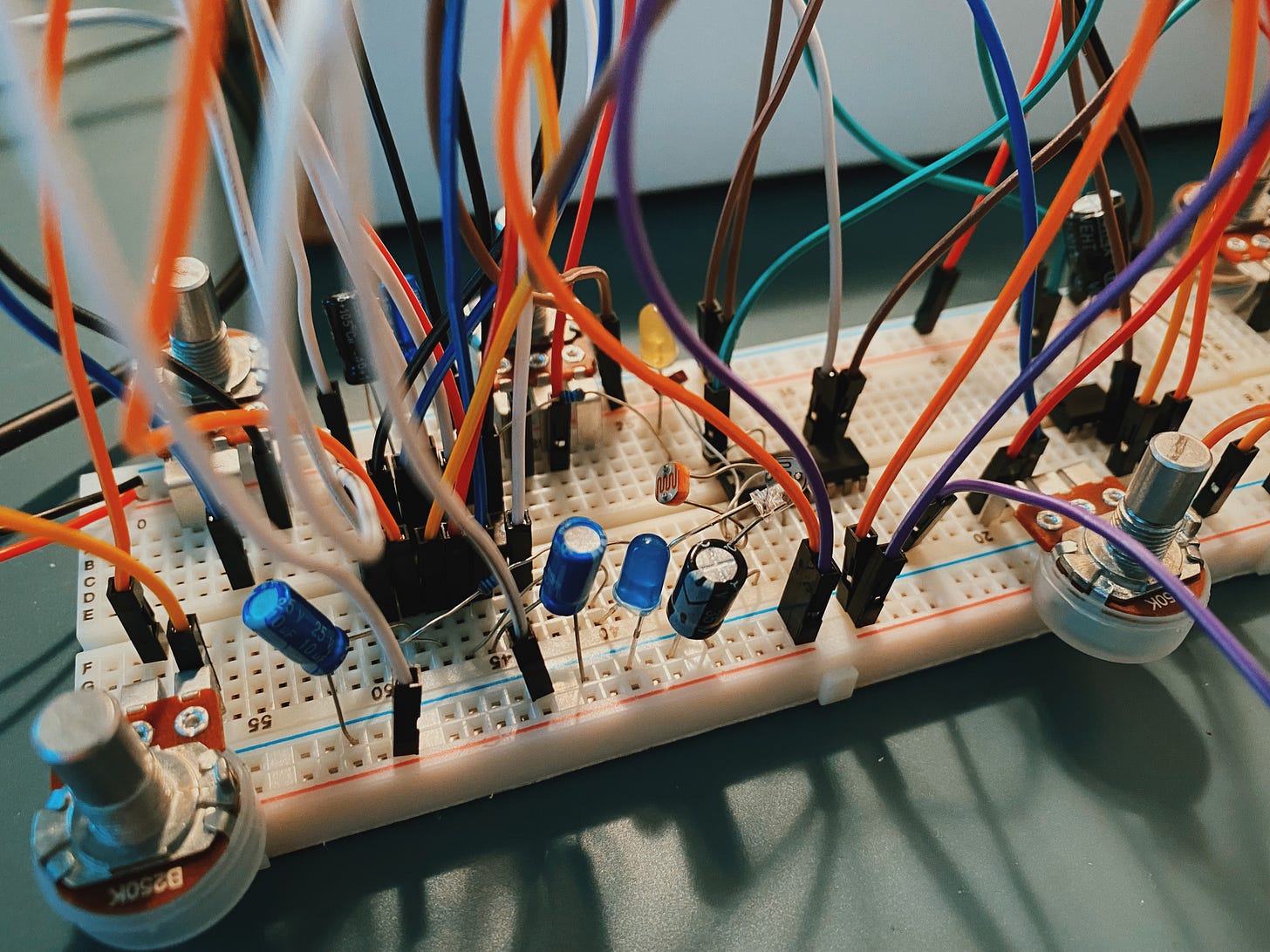Electric Mushrooms and the Circuitry that Loves Them
Synthesis and Resistance in the Rhizomorphic Substrate
A synthesizer is a reed instrument where electricity replaces human breath. It is a bassoon for power outlets. In a brass band, lungs push air into and through the instrument. That air is “signal,” and it winds through the structure of your lips to navigate metallic pistons. The shape of that path is based on the way you move your fingertips across valves.
Just like the shape of a tuba or piccolo can transform the sound of air in your lungs, the “shape” of a synthesizer — and the manipulation of the path through it — transforms the sound of electricity.
For a month or two I’ve been assembling some of these electronic breath-pistons for a piece supported by Science Gallery Detroit and in collaboration with Claudia Westermann, Vinny Montag and researchers at the Xi'an Jiaotong-Liverpool University (XJTLU), called “Appetite for Deconstruction.” It’s meant assembling pieces into a Eurorack kit, and building my own variety of oscillators and filters thanks to an online course by the always-excellent Dogbotic Labs in Berkeley, CA.
Living things produce electrical signals on their surface, whether it’s human skin or the cap of a blooming mushroom. A synthesizer can be designed to read this signal as voltage. The voltage can then control the synthesizer by moving through its components according to a specific structure. The structure is shaped by circuits, which usually assembled and sold as “modules” in a modular synth. The signal’s path between those modules is possible through the patchwork of wiring between those modules.
The mushroom is not the core of our concern. The centerpiece of this machine is electricity. Once the mushroom “gets into the system,” you can direct it in all kinds of ways, depending on where the wires connect to those modules. If you have never tried to do this, you might assume it’s like hooking up a stereo, where wires have a right place to be. That’s not the case. Instead, you have to make decisions about where the electricity needs to go in order to do the thing you need it to do; every hole in the module is an eligible candidate and there is really no way of knowing what it will do in combinations with other parts of that chain.
It’s not a sound system. It’s an electrical ecosystem. “Sound” is just what happens afterward.
Frog Legs and Young Love
Science has a long history of grappling with this weird unknown thing that pulses through and between things. Luigi Galvani got a dead frog to jump thanks to some antique jumper cables back in 1780, sparking what could be called an alchemy of voltage in the 18th and 19th centuries.
You had Franz Mesmer, theorizing on electricity as a “magnetic fluid,” a matter “which occupies all space; and that as all bodies moving in the world, abound with pores, this fluid matter introduces itself through the interstices and returns backwards and forwards, flowing through one body by the currents which issue therefrom to another, as in a magnet.” Mesmer (who also gave us “mesmerizing”) would use this idea of permeating electrical forces to advance the cause of electroshock therapy.
American school books will tell you it all started with Ben Franklin, but the Egyptians were getting shocked by catfish and eels back in 2750 BC. The term points to its origins in the natural world: it’s Greek, elektron, meaning amber; the electricity we know today is named because static electricity sticks stuff together. Goethe believed that this electrical relationship existed between and within us, creating a literal, physical compulsion to move closer to those we loved or might love, giving us our lothario definitions of “animal magnetism.”
Today electricity is woven into our walls, waiting. It oozes into appliances at our request. Electricity navigates circuits, or produces heat. Jef Raskin, the designer of early Macintosh computers, wrote that the structure of a toaster makes toast. There’s no other information in that machine, just wires and circuits arranged to deliver electricity in a way that suits the toaster’s purpose. Electricity can enter into a system and burn, as in a toaster, or sucking air out, as in a freezer. In either case, it’s a matter of directing energy to do what we need it to do depending on the box we’ve plugged in to it.
Data is written into lightning. We don’t remember this often enough. We live within the smartest network ever created, connected by electrical fields. The wires move through our walls, out to streets, connect our apartments to waterfalls pushing turbines; to atoms, split deep within nuclear towers, to the coal choking its way through chimneys. All of this is information, of a certain kind, it’s a signal waiting to communicate. A synthesizer is just one way of hearing it.
Electricity Finds a Voice
You might imagine particles entering a vast space within your synthesizer, like it’s an empty room needing to be filled. But empty rooms are already full of electricity. Like amber, it just needs to move. It’s movement that give electricity power: the pushing, rejecting, directing. Without all that, it’s “off.” Nowhere to go, nowhere to be. That movement needs a path to travel, and a synthesizer is nothing more than a plotted path. Every section of that path changes the magnetic ooze into a series of sections and subsections, or changes the length of its crests and dips.
In the photo above you’re seeing a maze for current. A 9V battery sends power moving through a conductive surface beneath that white plastic board. The wires move that energy to specific pieces of the board. The blue things are capacitors, which are like buckets — the current moves into them until it can’t hold them anymore, and then they all shoot out again, giving us rising and falling signals. The knobs you see there are potentiometers. Twist them, and you loosen a wire inside them, extending the length needed to travel through them, slowing the pulse of a wave: longer waves vibrate the speaker’s magnet more slowly than short waves. Slow movement is lower frequency (bass); fast movement is treble, or higher frequencies.
Ultimately, an analogue synthesizer is a big, thousand-dollar box for modifying the speed of a magnet in a speaker. Speakers are coiled wires that push or pull the diaphragm of the speaker into motion when electricity creates or releases its magnetic hold on those wires. When we build synthesizers, we are manipulating the pace of that magnetic vibration.
All of which shapes the sound at the other end, which is a mystifying experience. In a truly analogue system, there really isn’t any “sound” moving through the synth. The Yamaha SK keyboards I had as a kid were digital, your keys triggered chips that responded with digital information. I knew they weren’t recordings per se (I didn’t have a Mellotron, which played back actual tape loops). Digital synths work different from analogue ones.
As mentioned, analog synths, like the one I am building here, don’t make “sounds.” They make electric pulses. These pulses control the vibration of a speaker. The speaker makes sound. That’s it. That’s all the thing does. If you’ve ever taken a guitar cord and plugged it into an amplifier and touched the other end of that guitar cord, you’ve built a foundational synthesizer. It took an electric pulse from your hand, amplified it, and that amplification triggered the speaker to respond with the buzzy tone of your fingertips, a pulse of noise created because your fingers create random signals, which is white noise.
The analog synthesizer takes signals and controls them, creating clean waves in the shape of smooth curves or Staccato pulses. The modules and patchwork transform these pulses. We think of them as shapes to visualize them, but it is more accurate to say we are manipulating the movement of electricity through time, and we can hear these changes on the other side of headphones or a speaker system.
Mesmerized Mushrooms
So, now I’ve started growing a test mushroom. The mushroom will be doing the equivalent of touching the end of a guitar cord plugged into an amplifier. The difference is that we have set up a machine that can read that current and interpret it through a network of path cords and circuit boards, or “modules”. All living things create some form of this electric current.
The mushroom caps will be wired into the synthesizer through TENS (“Transcutaneous electrical nerve stimulation”) cables. These cables are designed for transmitting electric pulses to human skin as a noninvasive paint relief treatment. But because electricity can move anywhere that circuit board tells it to move, we can also extract electrical pulses from a living tissue surface, where it can be used as a control signal.
In the rig I’ve put together, these cables facilitate a flow of electricity from the living system to the inanimate one. The electric field generated by a thriving mushroom (or any living thing) can become an electrical signal that turns things off and on, directing the flow of our elektronik amber. In a sense, the mushroom gives our electricity purpose, directing it from room to room, changing the shape and flow of the outcoming waves.
To me, there’s something intuitive about this relationship between mushrooms and synthesizers. It takes us back a bit to that early impulse of explaining electricity through interconnectedness. It is not wrong to say that electricity is everywhere. The rules that govern its shapes and flows govern the universe. Our increasing power of control, paired with our expanding insight into those flows, ought to inspire awe.
A bit of mythmaking might be in order whenever we use a toaster or an electric toothbrush. So here we go.
For years, I thought ohms — the name we give to measurements of electrical resistance — were named for “ohm,” the vibrational foundation of consciousness that makes up and permeates our human reality. Turns out, the electric “Ohm” is just named for some German dude. It makes sense: Western science can be read as a form of resistance to the natural, overwhelming flow of entropy. The vibrations are shaped by resistance, the resistance is shaped by the vibrations. In the end, you get oscillations, and that, at the heart, is what a synthesizer does, too.
Stay tuned.
Thanks for reading! You can find me at @e_salvaggio on Twitter or my website, cyberneticforests.com.
Feel free to share this e-mail or link to it. If you care to sign up, you can do so with the button below. Thanks!







